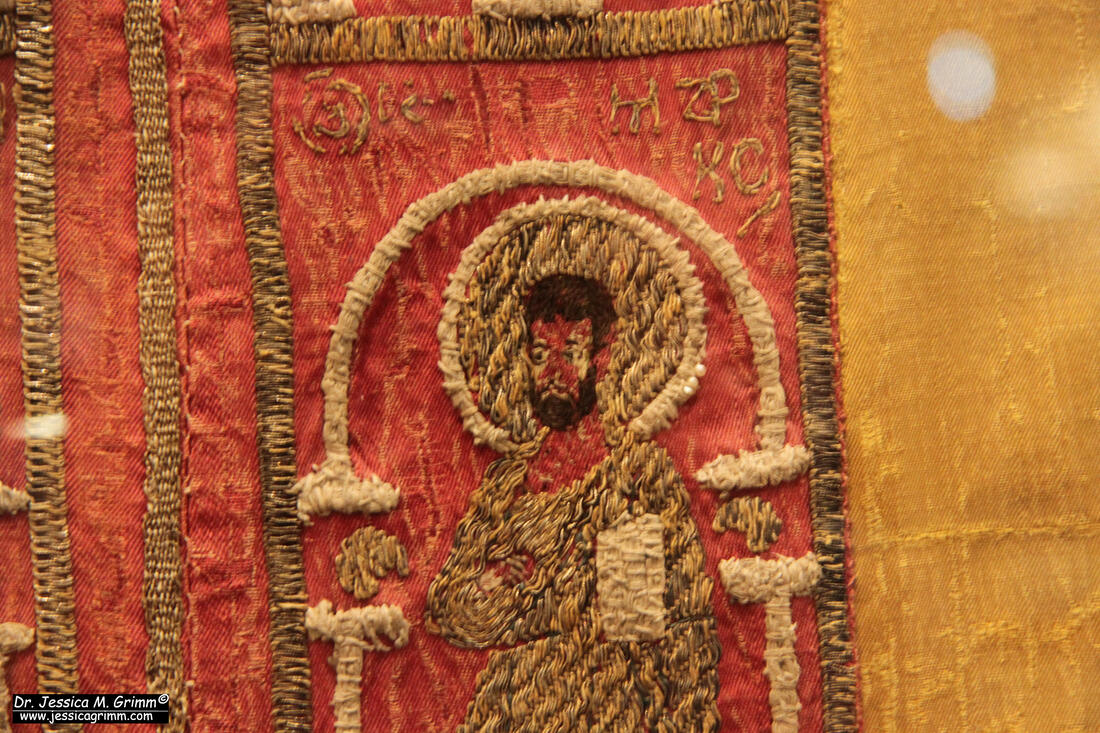|
A couple of weeks ago, I and my husband visited the lovely Diocesan Museum of Eichstätt. Apart from the normal sacral art on display, were a few important medieval vestments. The most interesting of them all is the so-called chasuble of St Willibald dating to the 12th-century. Goldwork embroidery was either made in Byzantium or in Cyprus according to the meagre information displayed in the museum and the literature. Originally, the shape of the chasuble would have been bell-shaped. The yellow silk twill dates to the 12th-century as well and was either made in Italy or in Byzantium. Although the chasuble is attributed to St. Willibald, he never wore it. St. Willibald was the founder of the diocese of Eichstätt und lived c. AD 700-787. Being the son of a Wessex chieftain and with a host of saintly relatives, he seems to have been predestined for the job! Depicted on the back of the chasuble are Jesus and Mary with 10 Apostles. Each figure is depicted under a Romanesque arch. The persons are identifiable through their stitched Greek names above the arches. The embroidery is worked on a strip of red silk twill. The goldthreads are couched down in pairs in a characteristic slanting couching pattern. Today, we are used to a couching pattern forming a brick pattern. However, a pattern forming a simple slant was very popular in the medieval period. As a rule of thumb: medieval embroideries where a single goldthread has been couched down are older than those where two (or more) goldthreads are couched down with each couching stitch. In this detail of Mary, you can see that her face and hands are stitched with small silken stitches. The literature states that these are stem and chain stitches. However, it looks more like irregular split stitch to me for the hands and typical "contour-following" split stitch as seen in Opus Anglicanum, for the face. Especially the latter can look like very fine chain stitches. The literature also states that Mary and Jesus were originally the only figures where the halo, architecture and clothing were further decorated with pearls. However, if you look carefully at the picture of the Apostle, you spot pearls there too. Just imagine what these embroideries once looked like with all the pearls still intact! As the pearls were padded with the beige string (linen or cotton) you see almost everywhere in these embroideries, the pearls would have sat proud of the surface catching the light better. The front of the chasuble was incredibly difficult to photograph due to a piece of modern art being right behind it. But you get an impression from the picture above. It is the same type of goldwork embroidery as seen on the back. Interestingly, many more pearls have survived on the front.
Unfortunately, it is unknown how this splendid piece of Byzantine embroidery ended up in the Cathedral treasury of Eichstätt. However, Eichstätt was an important Diocese in the Middle Ages and still has a Catholic University and Seminary. Literature Müller-Christensen, S., 1955. Sakrale Gewänder des Mittelalters. Hirmer, München.
8 Comments
Truus Notermans
12/7/2021 12:48:27
Haute Bordure is nog open tot 18 juli maar helaas zijn alle tijdslots al bezet. Daarom was ik heel blij met je info over de online tour. Die ga ik heerlijk helemaal bekijken.
Reply
Kimberly
12/7/2021 15:34:22
Jessica, thank you for sharing more of your adventures and finds. This one is a delight. You mentioned the pearls on the surface. Are these saltwater or freshwater pearls? What is the connection between pearls and ecclesiastical embroidery? Is this symbolic? a display of grandeur? other?
Reply
12/7/2021 18:13:25
Thank you, Kimberley. These are fresh-water pearls. Although they could be found in many clean rivers and lakes in the world, getting your hands on enough of them and drilling a hole through them, made them very expensive. This explains their connection with goldwork embroidery (both for the church and for the ruling class).
Reply
According to Tanya Bentham (opusanglicanum blog), one can be sitting working split stitch as a demonstration, only for members of the public to state with great confidence that no, it isn't split stitch, it's chain stitch.
Reply
16/7/2021 09:30:15
That made me cringe, Rachel. Yes, the things people tell you when you are demonstrating embroidery. I could write a book about it by now :). And yes, I agree, we need more "real" embroiderers as consultants in museum settings.
Reply
15/10/2021 20:46:54
Is there any research on which dyes are used for the red silk ribbon? That would be interesting.
Reply
15/10/2021 20:59:48
Nothing is mentioned in the reference stated. As far as I know, there isn't a more recent reference available. You could try contacting the museum.
Reply
Your comment will be posted after it is approved.
Leave a Reply. |
Want to keep up with my embroidery adventures? Sign up for my weekly Newsletter to get notified of new blogs, courses and workshops!
Liked my blog? Please consider making a donation or becoming a Patron so that I can keep up the good work and my blog ad-free!
Categories
All
Archives
July 2024
|
Contact: info(at)jessicagrimm.com
Copyright Dr Jessica M. Grimm - Mandlweg 3, 82488 Ettal, Deutschland - +49(0)8822 2782219 (Monday, Tuesday, Friday & Saturday 9.00-17.00 CET)
Impressum - Legal Notice - Datenschutzerklärung - Privacy Policy - Webshop ABG - Widerrufsrecht - Disclaimer
Copyright Dr Jessica M. Grimm - Mandlweg 3, 82488 Ettal, Deutschland - +49(0)8822 2782219 (Monday, Tuesday, Friday & Saturday 9.00-17.00 CET)
Impressum - Legal Notice - Datenschutzerklärung - Privacy Policy - Webshop ABG - Widerrufsrecht - Disclaimer











 RSS Feed
RSS Feed